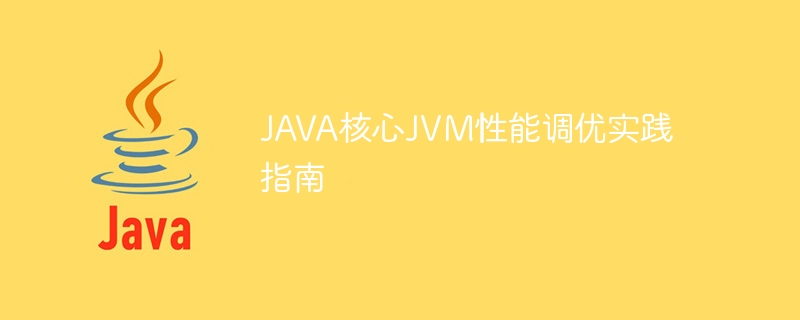
"Java Core JVM Performance Tuning Practice Guide"
With the rapid development of Internet technology, Java, as a widely used programming language, is used in various systems and plays an important role in applications. However, as the system scale expands and the number of users increases, performance optimization of Java programs becomes particularly important. Among them, JVM performance optimization is a key part, because JVM is the core execution environment of Java programs. In order to better optimize JVM performance, we need to have an in-depth understanding of how the JVM works and practice it with specific code examples.
1. Understand the working principle of JVM
- Memory management
The memory of JVM is divided into heap memory and stack memory. Heap memory is mainly used to store object instances and arrays, while stack memory is mainly used to store local variables and method calls. When tuning JVM performance, we need to pay attention to memory allocation, usage and recycling to avoid memory leaks and frequent garbage collection. The following are some common memory optimization strategies:
- Set the heap memory size and stack memory size reasonably to avoid performance problems caused by being too large or too small.
- Use the heap memory generational recycling mechanism to reasonably set the ratio of the new generation to the old generation, as well as the ratio of the Eden space and Survivor space of the new generation. It can be set through parameters "-Xmn", "-XX:NewRatio", etc.
- Use appropriate garbage collectors, such as parallel collectors, CMS collectors, G1 collectors, etc. You can choose the appropriate garbage collector according to specific scenarios.
- Class loading
The JVM uses lazy loading for class loading, that is, it will load the class only when it is needed. In practical applications, a large number of class loadings will affect the performance of the system. Therefore, when tuning JVM performance, we need to pay attention to the class loading situation and minimize the number and time of class loading. The following are some common class loading optimization strategies:
- Use class loading cache to preload some commonly used classes into memory to avoid repeated loading.
- Use a class loading scanner to reduce the scope and number of scans and improve loading speed.
- Use class loading preheating to load classes that may be heavily used in advance to avoid loading them when they are actually used.
2. Performance Optimization Practice
- Garbage Collection Optimization
Garbage collection is one of the focuses of JVM performance optimization. In practical applications, frequent garbage collection will cause system pauses and affect user experience. Therefore, we need to select an appropriate garbage collector for specific scenarios, adjust garbage collection parameters, and use concurrent garbage collection and other technologies to optimize garbage collection. The following is a code example using the G1 garbage collector:
// 启用G1垃圾收集器 java -XX:+UseG1GC -Xms2g -Xmx2g -XX:MaxGCPauseMillis=200 -XX:+PrintGCDetails -jar your-application.jar
Copy after login
- Memory Optimization
Memory optimization is also one of the focuses of JVM performance tuning. In actual applications, large heap memory and stack memory will cause frequent garbage collection and cause system pauses. Therefore, we need to set the size of heap memory and stack memory reasonably, use the memory generational recycling mechanism, and avoid the occurrence of memory leaks. The following is a code example for setting heap memory size, stack memory size and garbage collection parameters:
// 设置堆内存大小、栈内存大小和垃圾回收参数 java -Xms2g -Xmx2g -Xss256k -XX:NewRatio=3 -XX:SurvivorRatio=8 -XX:MaxTenuringThreshold=15 -XX:InitialTenuringThreshold=10 -XX:MaxGCPauseMillis=200 -XX:G1HeapRegionSize=4m -XX:ParallelGCThreads=4 -jar your-application.jar
Copy after login
- Class loading optimization
Class loading optimization is also a part of JVM performance tuning aspect. In practical applications, a large number of class loadings will affect the performance of the system. Therefore, we need to reduce the number and time of class loading through technologies such as caching, scanners, and preheating. The following is a code example using class loading cache:
// 使用类加载缓存 public class ClassLoaderCache { private Map> cache = new HashMap<>(); public Class loadClass(String className) throws ClassNotFoundException { if (cache.containsKey(className)) { return cache.get(className); } Class clazz = Class.forName(className); cache.put(className, clazz); return clazz; } }
Copy after login
3. Summary and Outlook
In the practice of JVM performance tuning, we need to have an in-depth understanding of the working principle of the JVM. Choose the appropriate optimization strategy for specific application scenarios. By optimizing aspects such as garbage collection, memory allocation, and class loading, the performance of Java programs can be effectively improved, and the stability of the system and user experience can be improved. In the future, with the continuous development of JVM technology, we can further explore new performance optimization technologies to provide more possibilities for improving the performance of Java programs.
To sum up, the "Java Core JVM Performance Tuning Practice Guide" aims to help developers better understand the working principle of the JVM and master the specific methods and technologies of JVM performance optimization, thereby improving the performance of Java programs. performance. We hope that the theoretical knowledge and code examples provided in this article can provide readers with certain reference and guidance for JVM performance tuning in practical applications.
The above is the detailed content of JAVA Core JVM Performance Tuning Practice Guide. For more information, please follow other related articles on the PHP Chinese website!


